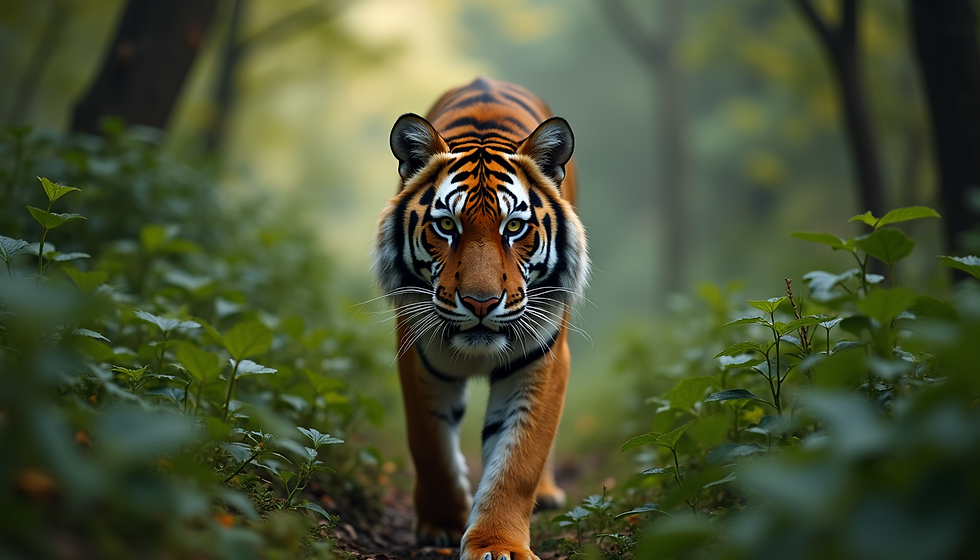The Ultimate Guide to the Best Time for Visiting Jim Corbett National Park
- Khushi Agarwal

- Sep 2
- 4 min read
Jim Corbett National Park, nestled in the foothills of the Himalayas, is a marvel of biodiversity and stunning landscapes. Renowned for its rich wildlife, including the majestic Bengal tiger, the park draws nature lovers and wildlife enthusiasts from around the world. However, the timing of your visit can greatly influence your experience. This guide will discuss the best times to explore Jim Corbett National Park, focusing on weather, wildlife sightings, and visitor experiences.
Understanding Jim Corbett National Park:-
Established in 1936, Jim Corbett National Park is India's oldest national park, covering an extensive area of over 520 square kilometers. It is a vital part of the Corbett Tiger Reserve, known for diverse flora and fauna, which includes over 600 species of birds, various mammals, and a broad range of plant species.
The park is divided into several zones: Dhikala, Bijrani, Jhirna, and Durgadevi. Each zone offers unique wildlife experiences and scenic beauty, making it essential to choose the right time based on your interests and objectives for the visit.
Best Time to Visit Jim Corbett National Park:-
1. Winter Season (November to February)
The winter months are among the best times to visit Jim Corbett National Park. During these months, temperatures range from 5°C to 20°C, creating a cool and pleasant atmosphere.
Wildlife Sightings
In winter, animals are more active and often easier to spot. For example, sightings of tigers and leopards increase by up to 30% compared to other seasons. Additionally, over 100 migratory bird species visit the park, making it ideal for birdwatchers and photographers.

Visitor Experience
The comfortable weather allows for enjoyable safaris, especially during early mornings and late afternoons. However, since this is peak tourist season, booking accommodations and safari permits in advance is crucial.
2. Spring Season (March to April)
Spring is a great time to visit Jim Corbett National Park as temperatures range from 15°C to 30°C. The weather is warm but manageable.
Wildlife Sightings
As the dry season sets in, wildlife becomes more active as animals search for water sources. This period offers a strong chance of tiger sightings near rivers and lakes. The park's flowers are in full bloom, making the surroundings vibrant and picturesque.
Visitor Experience
Spring brings a quieter atmosphere with fewer crowds compared to winter, allowing for a more personal experience with nature. Remember to dress appropriately for the temperature variations throughout the day and stay hydrated.
3. Summer Season (May to June)
Summer can be quite hot, with temperatures often reaching up to 40°C. Despite the heat, this season has specific advantages for wildlife seekers.
Wildlife Sightings:-
Animals congregate around water sources, increasing the chances of spotting them. This period is particularly favorable for seeing tigers, especially during the early morning and late evening when temperatures drop. For instance, sightings can rise to over 70% during these times due to animals’ behavior.

Visitor Experience
Even though the heat can be challenging, the park is less visited at this time, leading to a tranquil experience. To beat the heat, plan your safaris for the cooler mornings and evenings.
4. Monsoon Season (July to September)
The monsoon season brings heavy rainfall and transforms the park’s landscape. Safaris are not allowed during this time, but the park showcases stunning natural beauty.
Wildlife Sightings
Wildlife sightings are limited due to the park's closure. However, the richness of the greenery during this period is remarkable. For photographers and artists, this is a visually stunning time to visit.
Visitor Experience
If solitude and tranquility appeal to you, the monsoon period is perfect. The lush landscapes make for serene walks near the park's boundaries, and the sound of rain enhances the peaceful atmosphere. Before planning a visit during this time, it's essential to check the park's operational status.
Key Considerations for Your Visit:-
Safari Zones
With multiple zones in the park, each has its own wildlife highlights. Researching the different zones will help you pick the best one based on your interests.
Accommodation
Make sure to book your stay in advance, especially during peak seasons. The range of accommodations varies from luxury resorts to budget-friendly lodges, catering to different preferences and budgets.
Safari Permits
You need safari permits to enter the park. Booking can be done online or at the entrance, but securing your preferred time slot well in advance is advisable, particularly in peak season.
Weather Conditions
Understanding the weather for your planned visit is crucial. Dress in layers for winter visits, while lightweight clothing is more suitable for the summer heat.
Wrapping Up Your Adventure:-
Selecting the best time to visit Jim Corbett National Park can significantly impact your experience. Whether you are drawn to the crisp winters, vibrant springs, or tranquil monsoons, each season offers unique opportunities for wildlife encounters and natural beauty.
By considering the factors discussed in this guide, you can ensure a memorable journey to one of India’s most treasured national parks. Embrace the adventure and immerse yourself in the breathtaking beauty of Jim Corbett National Park.










Comments